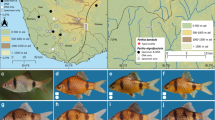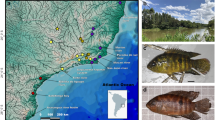Abstract
Molecular phylogeny of three genera containing nine species and subspecies of the specialized schizothoracine fishes are investigated based on the complete nucleotide sequence of mitochondrial cytochromeb gene. Meantime relationships between the main cladogenetic events of the specialized schizothoracine fishes and the stepwise uplift of the Qinghai-Tibetan Plateau are also conducted using the molecular clock, which is calibrated by geological isolated events between the upper reaches of the Yellow River and the Qinghai Lake. Results indicated that the specialized schizothoracine fishes are not a monophyly. Five species and subspecies ofPtychobarbus form a monophyly. But three species ofGymnodiptychus do not form a monophyly.Gd. integrigymnatus is a sister taxon of the highly specialized schizothoracine fishes whileGd. pachycheilus has a close relation withGd. dybowskii, and both of them are as a sister group ofDiptychus maculatus. The specialized schizothoracines fishes might have originated during the Miocene (about 10 MaBP), and then the divergence of three genera happened during late Miocene (about 8 MaBP). Their main specialization occurred during the late Pliocene and Pleistocene (3.54-0.42 MaBP). The main cladogenetic events of the specialized schizothoracine fishes are mostly correlated with the geological tectonic events and intensive climate shift happened at 8, 3.6, 2.5 and 1.7 MaBP of the late Cenozoic. Molecular clock data do not support the hypothesis that the Qinghai-Tibetan Plateau uplifted to near present or even higher elevations during the Oligocene or Miocene, and neither in agreement with the view that the plateau uplifting reached only to an altitude of 2000 m during the late Pliocene (about 2.6 MaBP).
Similar content being viewed by others
References
Paul, T., Xu, Z., Francoise, R. et al., Oblique stepwise rise and growth of the Tibet Plateau, Science, 2001, 294(23): 1671–1677.
Harrison, T. M., Copeland, P., Kidd, W. S. F. et al., Raising Tibet, Science, 1992, 255: 1663–1670.
Fielding, E., Tibet uplift and erosion, Tectonophysics, 1996, 260: 55–84.
Zhong, D. L., Ding, L., Rising process of the Qinghai-Xizang (Tibet) Plateau and its mechanism, Science in China, Ser. D, 1996, 39(4): 369–379.
Li, J. J., Fang, X. M., Uplift of the Tibetan Plateau and environmental changes, Chinese Science Bulletin, 1998, 44(23): 2117–2125.
Cao, W. X., Chen, Y. Y., Wu, Y. F. et al., Origin and evolution of schizothoracine fishes in relation to the upheaval of the Xizang Plateau, in Collection in Studies on the Period, Amplitude and Type of the Uplift of the Qinghai-Xizang Plateau (in Chinese) (ed. The Team of the Comprehensive Scientific Expedition to the Qinghai-Xizang Plateau, Chinese Academy of Sciences), Beijing: Science Press, 1981, 118–130.
Wu, Y. F., Studies on phylogeny of subfamily Schizothoracinae (Pisces, Cypriniformes, Cyprinidae) in China, Acta Biologica Plateau Sinica (in Chinese), 1984, 3: 119–140.
Wu, Y. F., Tan, Q. J., Characteristics of the fish-fauna of the characteristics of Qinghai-Xizang Plateau and its geological distribution and formation, Acta Zootaxonomic Sinica (in Chinese), 1991, 37(2): 135–151.
Chen, Y. F., Phylogeny and distributional patterns of subfamily Schizothoracinae (Pisces, Cypriniformes, Cyprinidae): I. Phylogenetic Relationships, Acta Zootaxon Sinica (in Chinese), 1998, 23(Special J Zoogeography): 17–25.
Chen, Y. F., Chen, Y. Y., Phylogeny and distributional patterns of subfamily Schizothoracinae (Pisces, Cypriniformes, Cyprinidae): II. Distributional patterns and eroding headward of Yellow River, Acta. Zootaxon Sinica (in Chinese), 1998, 23(Special J Zoogeography): 26–34.
Chen, Z. M., Chen, Y. F., Phylogeny of the specialized schizothoracine fishes (Teleostei: Cypriniformes: Cyprinidae), Zoological Studies, 2001, 40(2): 147–157.
Chen, Z. M., Chen, Y. F., Genetic relationships of the specialized schizothoracine fishes inferred from random amplified polymorphic DNA analysis, Zoological Research (in Chinese), 2000, 21(4): 262–268.
Tsigenopoulos, C. S., Berrebi, P., Molecular phylogeny of North Mediterranean freshwater barbs (GenusBarbus: Cyprinidae) inferred from cytochromeb sequences: Biogeographic and systematic implications, Mol. Phylogenet. Evol., 2000, 14(2): 165–179.
Kotlik, P., Berrebi, P., Genetic subdivision and biogeography of the Danubian phylogenetic analysis of mitochondrial DNA variation. Mol. Phylogenet Evol., 2002, 24: 10–18.
Sambrook, J., Russell, D. W. et al., Molecular Cloning: A Laboratory Manual, 3rd ed. (in Chinese, Translated by Huang, P. T. et al.), Beijing: Science Press, 2002, 463–618.
Thompson, J. D., Higgins, D. G., Gibson, T. J., CLUSTAL W: Improving the sensitivity of progressive multiple sequence alignment through sequence weighting, positions-specific gap penalties and weight matrix choice, Nucleic Acids Research, 1994, 22: 4673–4680.
Kumar, S., Tamura, K., Nei, M., MEGA: Molecular evolutionary genetics analysis, University Park, PA: Pennsylvania State University, 1993.
Wu, Y. F., Chen, Y. Y., Fossil cyprinid fishes from the late Tertiary of north Xizang, China Verteb. Palasiatica (in Chinese), 1980, 13: 15–20.
Swofford, D. L., PAUP* Phylogenetic analysis using parsimony (*and other methods), Version 4, Sunderland, Massachusetts: Sinauer Associates, 1998–2002.
Posada, D., Crandall, K. A., Modeltest: testing the model of DNA substitution, Bioinformatics, 1998, 14: 817–818.
Tamura, K., Nei, M., Estimation of the number of nucleotide substitutions in the control region of mitochondrial DNA in humans and chimpanzees, Mol. Biol. Evol., 1993, 10(3): 512–526.
Felsenstein, J., Confidence limits on phylogenies: An approach using the bootstrap, Evolution, 1985, 39: 783–791.
Muse, S. V., Weir, B. S., Testing for equality of evolutionary rates, Genetics, 1992, 132: 269–276.
Takezaki, N., Rzhetsky, A., Nei, M., Phylogenetic tests of the molecular clock and linearized trees, Mol. Biol. Evol., 1995, 12: 823–833.
Strimmer, K., Haeseler, A.von, Quartet puzzling: A quartet maximum likelihood method for reconstructing tree topologies, Mol. Biol. Evol., 1996, 13: 964–969.
Li, J. J., Fang, X. M., Ma, H. Z. et al., Geomorphologic and environmental evolution in upper reaches of Yellow River during the late Cenozoic, Science in China, Ser. D, 1996, 39(4): 380–390.
Li, J. J., Fang, X. M., Pan, B. T., Late Cenozoic intensive uplift of Qinghai-Xijiang Plateau and its impacts on environments in surrounding area, Quaternary Sciences, 2001(5): 381–391.
Nei, M., Molecular Evolutionary Genetics, New York: Columbia University Press, 1987.
Huang, S. Y., Chen, Y. Y., Phylogenetic relationships ofDiptychus chungtienensis andD. kaznakovi with special reference to the zoogeographical analysis, Acta. Zootaxonomic Sinica (in Chinese), 1986, 11(1): 100–107.
Martin, A. P., Palumbi, S. R., Body size, metabolic rate, generation time and the molecular clock, Proc. Natl. Acad. Sci. USA, 1993, 90: 4087–4091.
Perdices, A., Doadrio, I., The molecular systematics and biogeography of the European cobitids based on mitochondrial DNA sequences, Mol. Phylogenet. Evol., 2001, 19: 468–478.
Zardoya, R., Doadrio, I., Molecular evidence on the evolutionary and biogeographical patterns of European cyprinids, J. Mol. Evol., 1999, 49: 227–237.
Machordom, A., Doadrio, I., Evidence of a Cenozoic Betic-Kabilian connection based on freshwater fish phylogeography (Luciobarbus, Cyprinidae), Mol. Phylogenet. Evol., 2001, 18: 252–263.
Durand, J., Tsigenopoulos, C., Ünlü, E. et al., Phylogeny and biogeography of the family Cyprinidae in the Middle East inferred from cytochromeb DNA-evolutionary significance of this region, Mol. Phylogenet. Evol., 2002, 22(1): 91–100.
Kroon, D., Steens, T., Troelstra, S. R., Onset of monsoonal related upwelling in the western Arabian Sea as revealed by planktonic foraminifers, Proc. ODP Sci. Res., 1991, 116: 257–263.
Harrison, T. M., Copeland, P., Kidd, W. S. F. et al., Activation of the Nyainqentanghla shear zone: implications for uplift of the southern Tibetan Plateau, Tectonics, 1995, 14: 658–676.
Fang, X. M., Li, J. J., Zhu, J. J. et al., The absolute age and division of Cenozoic stratum from the Linxia Basin in Gansu Province, Chinese Science Bulletin (in Chinese), 1997, 42(14): 1458–1471.
An, Z., Kutzbach, J. E., Prell, W. L. et al., Evolution of Asian monsoons and phased uplift of the Himalayan-Tibetan Plateau since late Miocene times, Nature, 2001, 411: 62–66.
Liu, J. Q., Gao, T. G., Chen, Z. D. et al., Molecular phylogeny and biogeography of the Qinghai-Tibet Plateau endemicNannoglottis (Asteraceae), Mol. Phylogenet. Evol., 2002, 23: 307–325.
Zheng, H., Powell, C. M., An, Z. et al., Pliocene uplift of the northern Tibet Plateau, Geology, 2000, 28(8): 715–718.
Copeland, P., Harrison, T. M., Kidd, W. S. F. et al., Rapid early Miocene acceleration of uplift in the Gangdese belt, Xizangsouthern Tibet, and its bearing on accommodation mechanisms of the India-Asia collision, Earth and Planetary Science Letters, 1987, 86: 240–252.
Molnar, P., England, P., Martinod, J., Mantle dynamics, uplift of the Tibetan Plateau, and the Indian monsoon, Reviews of Geophysics, 1993, 31: 357–396.
Author information
Authors and Affiliations
Corresponding author
About this article
Cite this article
He, D., Chen, Y., Chen, Y. et al. Molecular phylogeny of the specialized schizothoracine fishes (Teleostei: Cyprinidae), with their implications for the uplift of the Qinghai-Tibetan Plateau. Chin. Sci. Bull. 49, 39–48 (2004). https://doi.org/10.1007/BF02901741
Received:
Issue Date:
DOI: https://doi.org/10.1007/BF02901741




